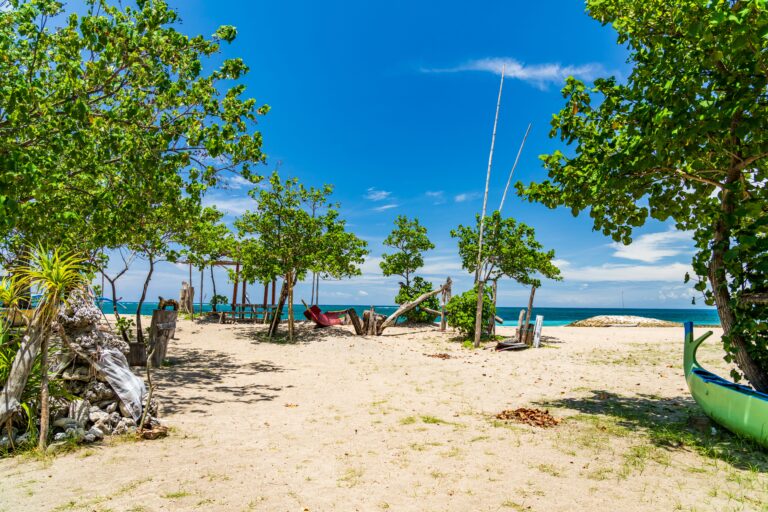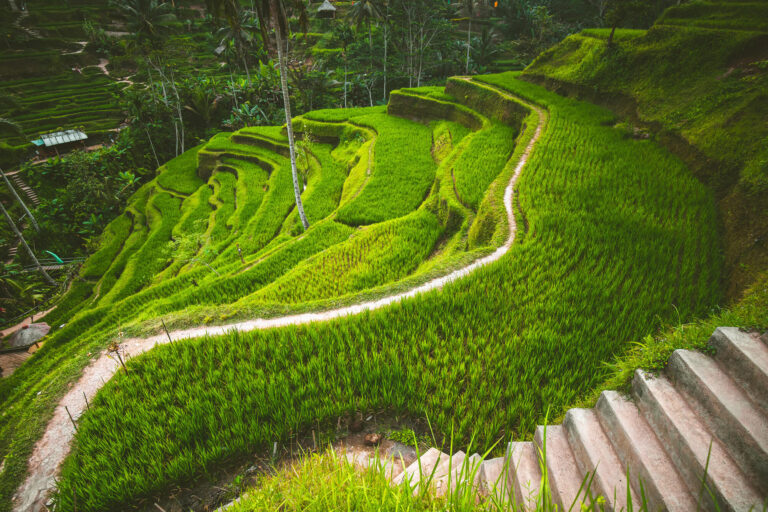Taman Ayun Temple is a beautiful temple that was the family temple of the Mengwi Dynasty.
Its proximity to Denpasar Town makes it one of the easier temples to get to in Bali and if you haven’t seen any other temples, it’s worth making the effort to see this one.
This is one of the “six royal temples of Bali” and that means it has real cultural and historical importance.
The name Taman Ayun Temple translates to “Garden Temple in the Water”.
Our guide to Taman Ayun Temple will ensure you know what to expect and what to look out for at this amazing temple.
Where Is Taman Ayun Temple?
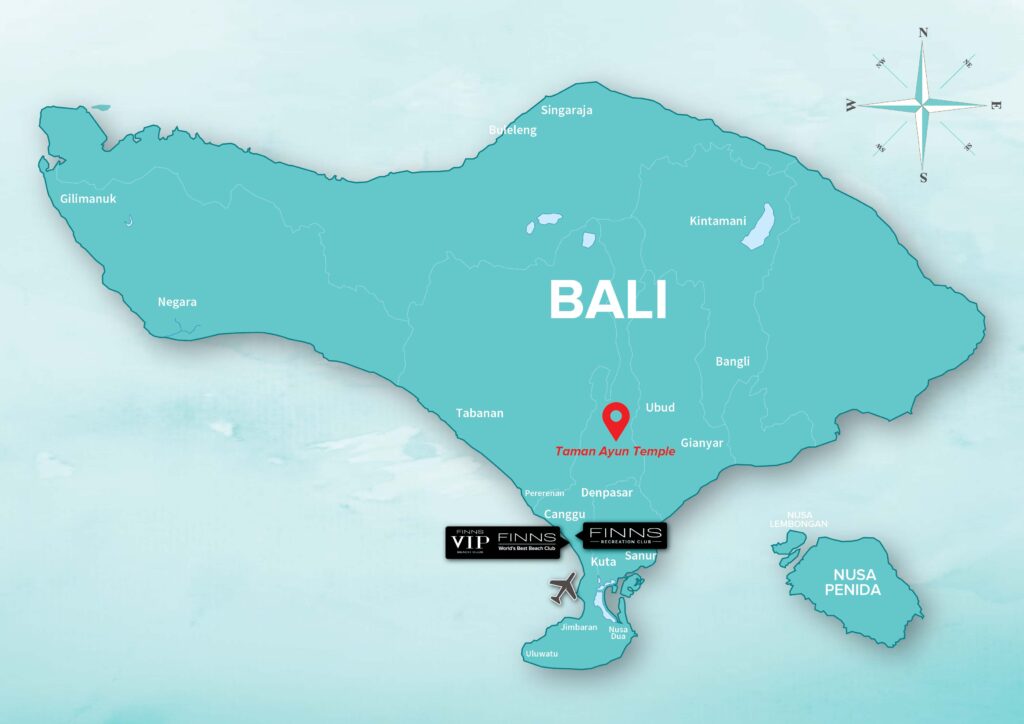
Taman Ayun Temple is in Mengwi Village which is in the Mengwi Sub-District of Badung Regency.
It’s about 18 kilometres to the North of Denpasar and on the major highway from Denpasar to Singaraja.
The address of Taman Ayun Temple is Jl. Ayodya No.10, Mengwi, Kec. Mengwi, Kabupaten Badung, Bali 80351, Indonesia
How To Get To Taman Ayun?

There is absolutely no public transport that runs to the Taman Ayun Temple of Mengwi Village so you only have a few options to get there:
Tour group – one of the best ways to see the temple shrines and holy places in Bali is to join an organized tour (you can book online easily enough). This is a very safe way to get around Bali and ensures that you get a local guide to show you around. This can transform a “small temple” into something much more interesting and this Mengwi Temple certainly deserves some light shining on its history and importance during your visit.
Private car and driver – if you are coming from quite far away or are looking to conduct a tour of other sites in and around Denpasar, it can be quite economical to hire your own car and driver. They will ensure you get to where you’re going and keep an eye on anything you leave in the vehicle while you visit the sights.
Grab or Go-Jek – hiring a driver using the ride-share apps is a great idea and it can be cheaper than hiring a private car and driver, but it also means that you may be waiting a while for a pick-up when you’re in a more remote location such as Mengwi Village.
Scooter – we never recommend using a scooter in Bali. It’s hard to ensure that you are road-legal and all insurance is invalid if you’re not road-legal. Accidents are a regular feature of scooter use in Bali and even experienced riders find the roads and traffic in Bali very challenging. It’s a terrible place to learn to ride and we’d rather people have fun on their holidays rather than spend them in a hospital.
When Is The Best Time To Vist Taman Ayun Temple?
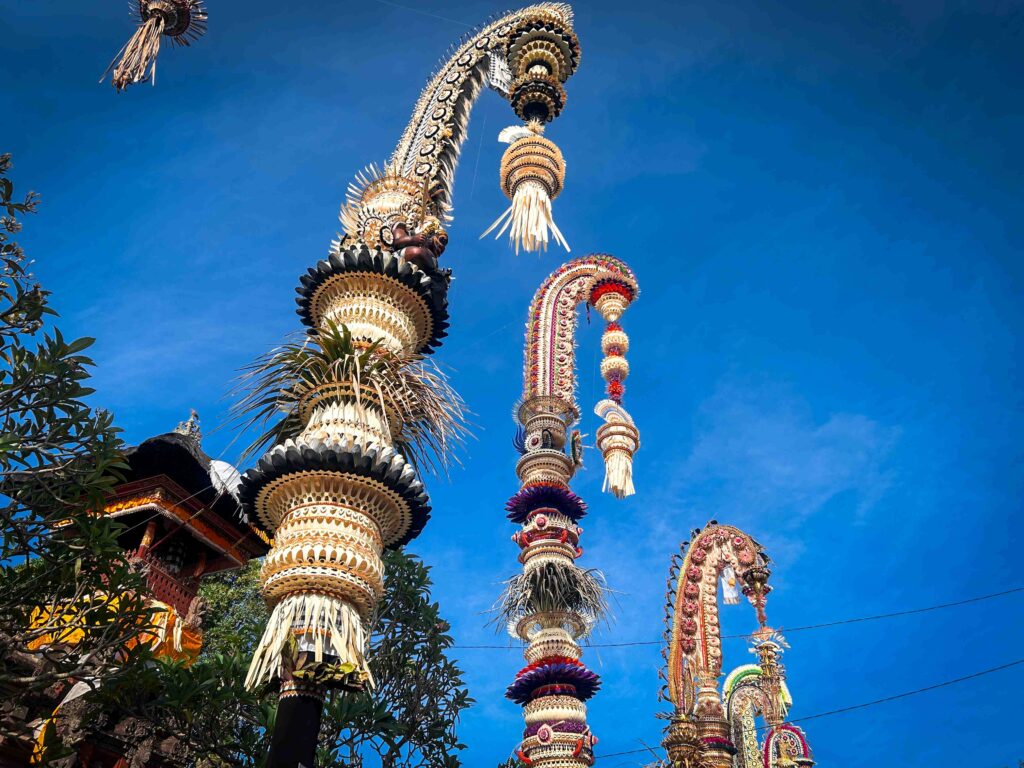
There is no best time of year to visit this temple and whether it’s the dry season or rainy season, you can enjoy the grounds all year round.
However, it can get very busy at this temple during the main part of the day as it’s very important to Balinese people and sees a lot of traffic.
If you want to get in without competing with the crowds and to get the best photographs, the earlier you get there, the better.
When Is Taman Ayun Temple Open?
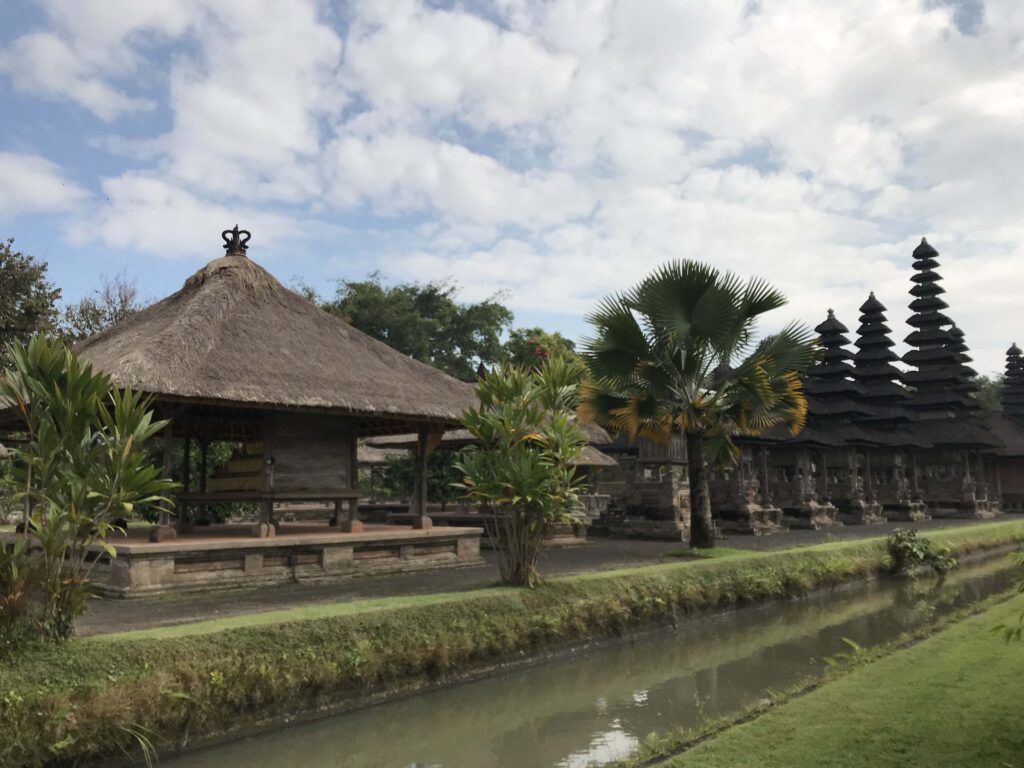
Taman Ayun Temple is open to visitors from 9 a.m. to 5 p.m. every day of the year except for the holiday of Nyepi.
Nyepi is observed in April and is essentially the New Year’s Day festival. However, unlike many other New Year festivals it’s known as the “Day of Silence”.
That is quite literal too. Everyone in Bali is required to stay at home from 6 a.m. to 6 a.m. the next day at Nyepi.
This means that every tourism site in Bali is closed for the day and foreign tourists are required to stay at their hotel complex for the day.
The only time you are allowed out of the house at Nyepi is if it’s a real emergency and you need to go to the hospital. Even the airport closes for the day.
The History Of Taman Ayun Temple
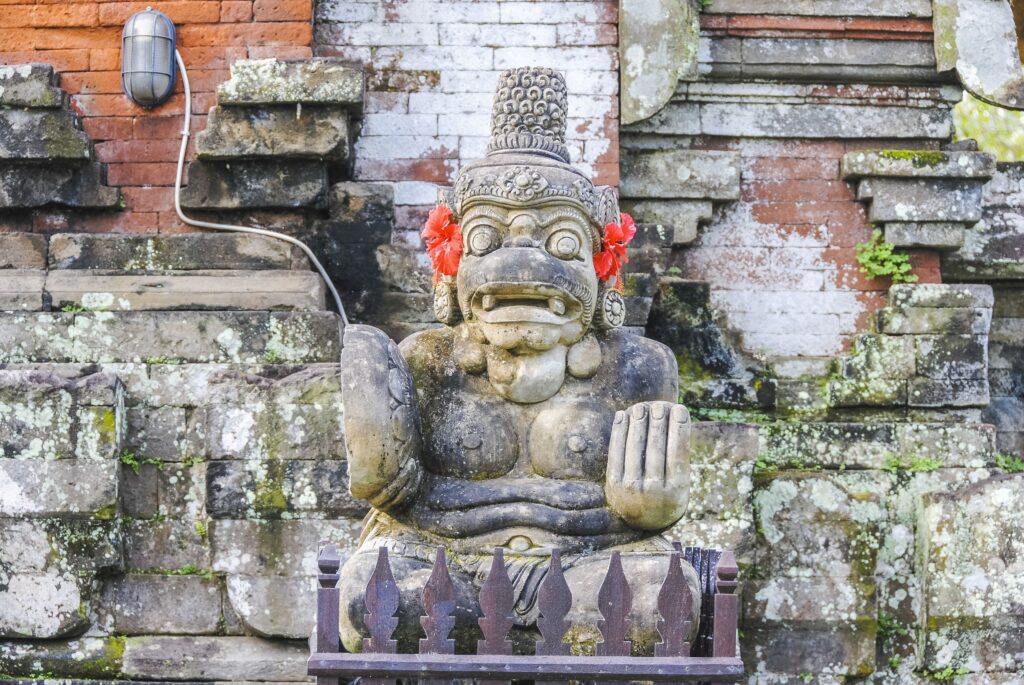
Taman Ayun Temple began construction in 1632 under the watchful eye of Tjokerda Sakti Blambangan, the first king of the Mengwi Empire, and it was completed just 2 years later in 1634.
Taman Ayun Temple is considered to be one of the most sophisticated temple designs in Bali and is more complex than most temples on the island.
There are definite Chinese architectural inspirations to be found if you carefully examine the buildings and statues of Taman Ayun Temple.
In 1937, the temple was fully restored and some of the work you see may be much more recent than the age of Taman Ayun Temple suggests.
In 2012, it was awarded a World Cultural Tourism Site status by UNESCO.
This is not quite the same as a World Heritage Site and, oddly, most of the Balinese nominees for the world heritage site list were withdrawn in 2015 in order to better conserve the sites for the Balinese people.
The first thing you notice when you get to Taman Ayun Temple is the towering tiers of the shrines that comprise the main profile of the temple.
They can also be seen as a physical reminder of the reverence that the Mengwi Kingdom held the royal family in.
This is a “daughter” temple of Besakih Temple (the Balinese mother temple) and was designed for those who could not travel to the mother temple to worship more locally.
Its main purpose was to unite the people and the ruling class of the Mengwi Kingdom.
The Four Courts Of Taman Ayun Temple
There are four courts or divisions at this temple and the first, the “Jaba” is the outer court. Here you will find a walkway over the ponds and there is only one entrance to this court.
There’s a guardian shrine just inside the entrance and the wantilan (hall) is for communal gatherings.
In the second inner court, there is a small temple known as Pura Luhurng Purnama. To get there you must pass through a second age which is covered in images of the Dewata Nawa Sanga (Hindu Gods).
There is another temple Pura Dalem Bekak behind the next gate in the third court and it has a high wooden bell tower (this is known as Bale Kulkul).
The inner court, known as Utama Mandala, is the most sacred area and is for ceremonial attendants only.
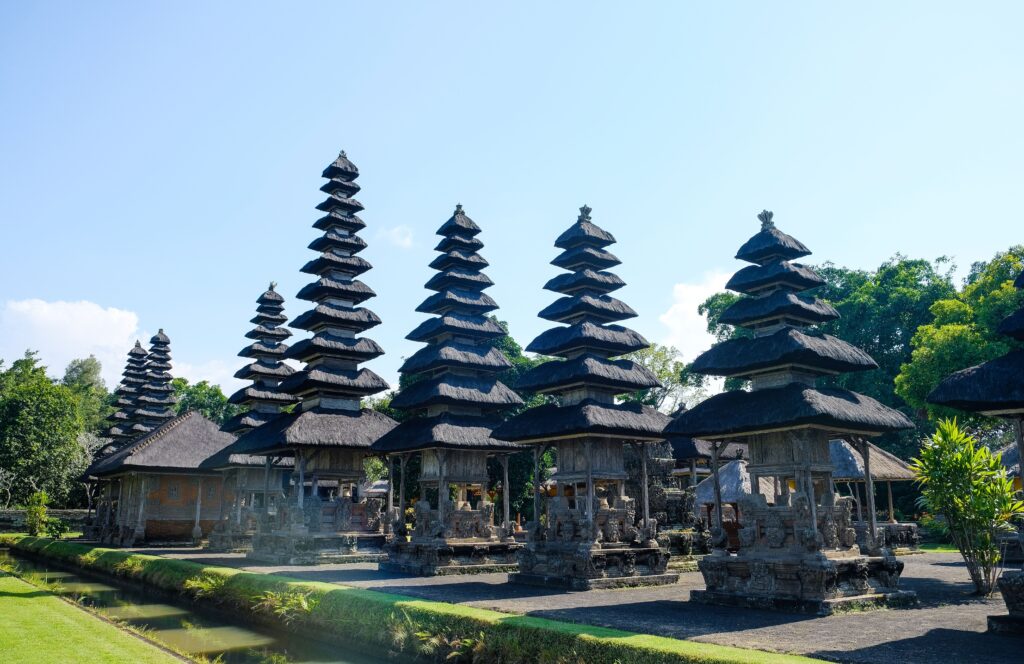
The Piodolan Ceremony Of Taman Ayun
Every Kiwon Medangsia (a date in the Balinese Pawukon calendar which has 210 days) the anniversary of the temple is celebrated and a visit on this day is likely to be very eventful.
Coincidentally, this is the same day as the Uluwatu Temple holds its piodolan (anniversary) ceremony.
What To Expect At Taman Ayun Temple
This temple has amazing architectural features and photographers and temple buffs are bound to enjoy exploring the site thoroughly.
It also has a beautiful garden which is fully landscaped and includes a wealth of lotus and fish ponds.
All Balinese temples require you to dress modestly and the Taman Ayun Temple is no exception.
If you are not covering your shoulders and legs, you may rent or buy a shawl and sarong at the entrance.
You must not attempt to enter this temple without being properly dressed, it could get you into a lot of trouble if you do.
Other Tips For Your Time At Taman Ayun Temple
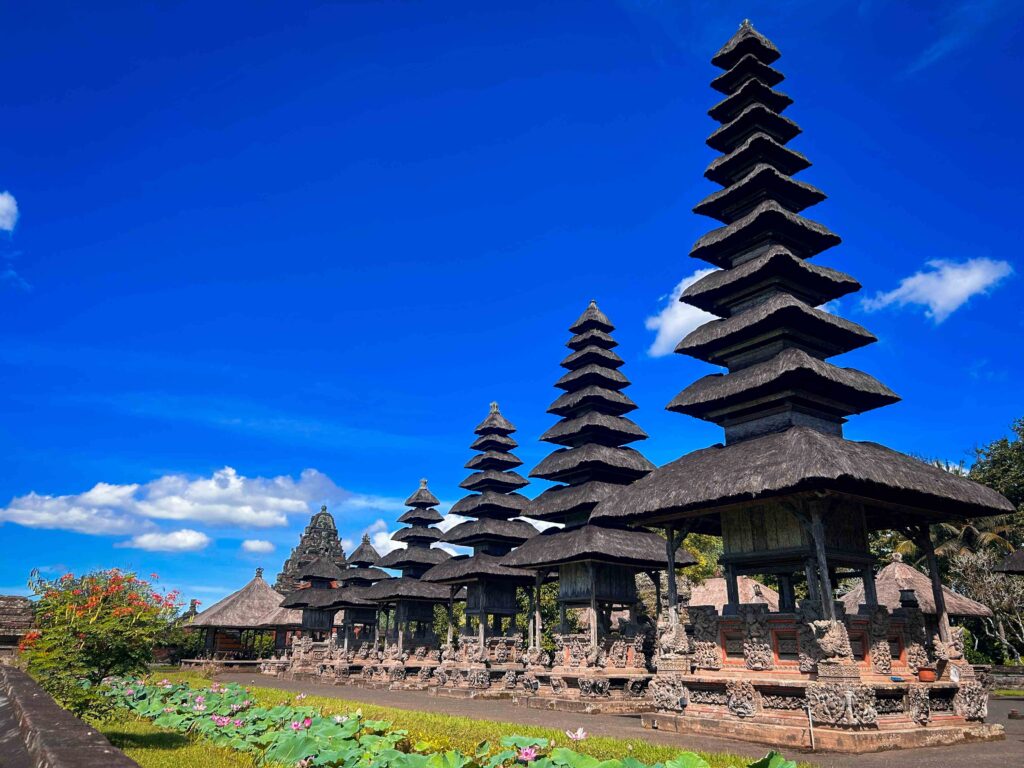
There are a few other things to remember when visiting Taman Ayan Temple:
Menstruating women must not enter Taman Ayun Temple. This is a rule in all temples in Bali not just Taman Ayun Temple and it is an indication of the status of menstruating women in the Hindu faith as “unclean”. This may sound awful to Westerners but it’s how to is in Bali.
Never tread on offerings. If you look on the ground, you may find offers called “canang sari” scatted at Taman Ayun Temple. Don’t tread on them please, it’s considered disrespectful.
Don’t take photos of worshippers at Taman Ayun Temple. It’s just not a nice thing to do.
Don’t use flash in buildings at Taman Ayun Temple. Much of Taman Ayun Temple is off-limits to tourists anyway but please don’t use flash if you do go inside any part of Taman Ayun Temple.
FAQs
How Old Is Taman Ayun Temple?
Taman Ayun Temple was built by King Tjokerda Sakti Blambangan in 1632 AD (the Javanese year was actually 1556). That makes it 391 years old as we go to press in 2023.
Though when this temple was built, the king was I Gusti Agung Putu, he wouldn’t become King Tjokerda Sakti Blambangan until later in his reign.
What Is The Dress Code For Taman Ayun Temple?
The dress code for all temples in Bali is the same as it is as Taman Ayun Temple. As long as a temple is still in use as a place of worship, you must dress modestly and respectfully.
In practice, this means you must cover your shoulders and your legs. The Balinese people achieve this by wearing a shawl and a sarong when they visit a temple.
If you don’t have the appropriate clothing on you, you can almost always rent or buy clothing at the temple grounds for a reasonable fee.
It is considered offensive to try and remove items of clothing within the temple and could get you into a lot of trouble.
Bali has seen a spate of tourists behaving disrespectfully at temples and the Bali Governor has vowed to have such tourists arrested, fined, potentially jailed and then deported.
What Does “Pura” Mean In Balinese?
It simply means “temple”. The word pura specifically refers to a Balinese Hindu Temple and not any other form of temple in Bali or Indonesia as a whole. Thus, when we say “Taman Ayun Temple” we can drop “pura”.
There are some Buddhist temples in Bali but they do not take the title “pura” and, of course, mosques are not considered to be temples at all.
A “pura” must be built according to specific formal rules that govern the architectural style, layout, and cultural trappings and using specific rituals at different phases of its construction.
How Old Is The Oldest Temple In Bali?
Pura Besikah is probably the oldest temple in Bali based on a period of continuous usage.
It is thought that the temple, though over 1,000 years old, was completed in the 15th century.
Pura Besikah is the Mother Temple for all of Bali and the complex it is on contains over 80 temples though not all of them are open to visitors and the general public.
Other contenders for the oldest temple could include Uluwatu Temple which was established in the 11th century.
Goa Gajah Temple is also very old, but it was buried in an earthquake and fell out of use for several hundred years.
How Much Is Taman Ayun Temple?
We assume this is a question regarding the entrance fee as you can’t buy any of the temples in Bali, they’re not for sale and we imagine that the public would be exceedingly unhappy if they ever were for sale.
Currently, at Taman Ayun Temple it’s just 20,000 IDR for tourists and 10,000 IDR for locals. Worshippers may access the site for free.
What Is The Biggest Temple In Bali?
The Besakih Temple is the biggest in Bali and that’s due to the sheer volume of temples on the site there.
No other temple in Bali comes close to covering as much land area.
What Is The Holiest Temple In Bali?
Pura Besakih is the holiest of all temples in Bali. (It’s worth noting that all temples are holy, however, and you shouldn’t consider one to be “less” than any other).
It is the “Mother Temple” of the nation and it is formally linked to every other temple on the island.
It’s an amazing place to visit too with spectacular views from the mountainside of rice paddies, mountains, streams and much more.
Be warned though, to get to the temples at Besakih, you have to climb quite a lot of stairs and there is no access for wheelchairs.
Final Thoughts On Pura Taman Ayun Temple Complex
Taman Ayun Temple is an amazing place and the Mengwi Village nearby is worth visiting too. It may be a small temple but it’s a world cultural tourism site and one that everyone remembers seeing.
If you want to see a temple complex in a beautiful garden during your time in Bali, you might want to visit this one. After all, if it’s good enough for Mengwi Royalty, it’s probably good enough for you.










